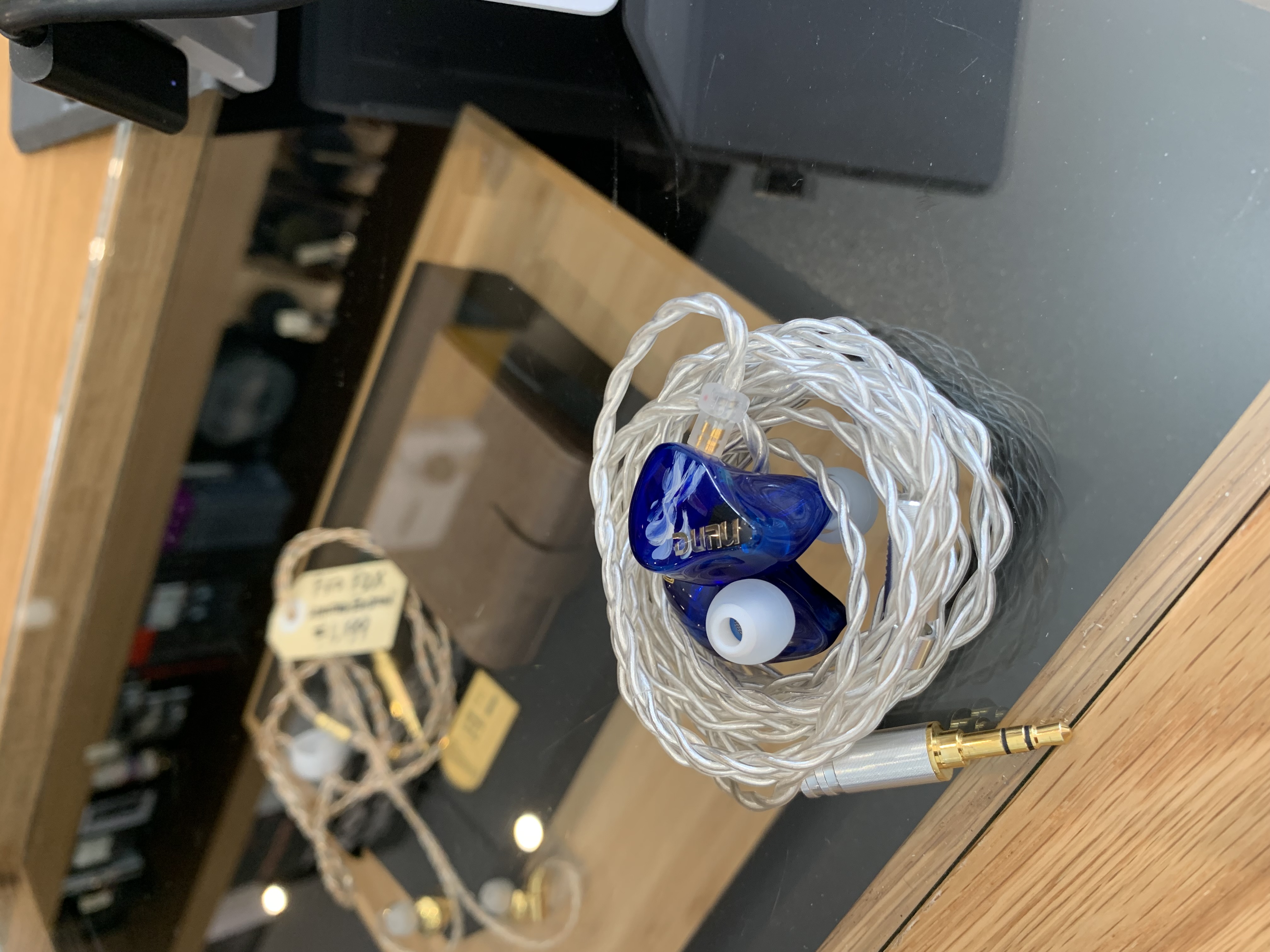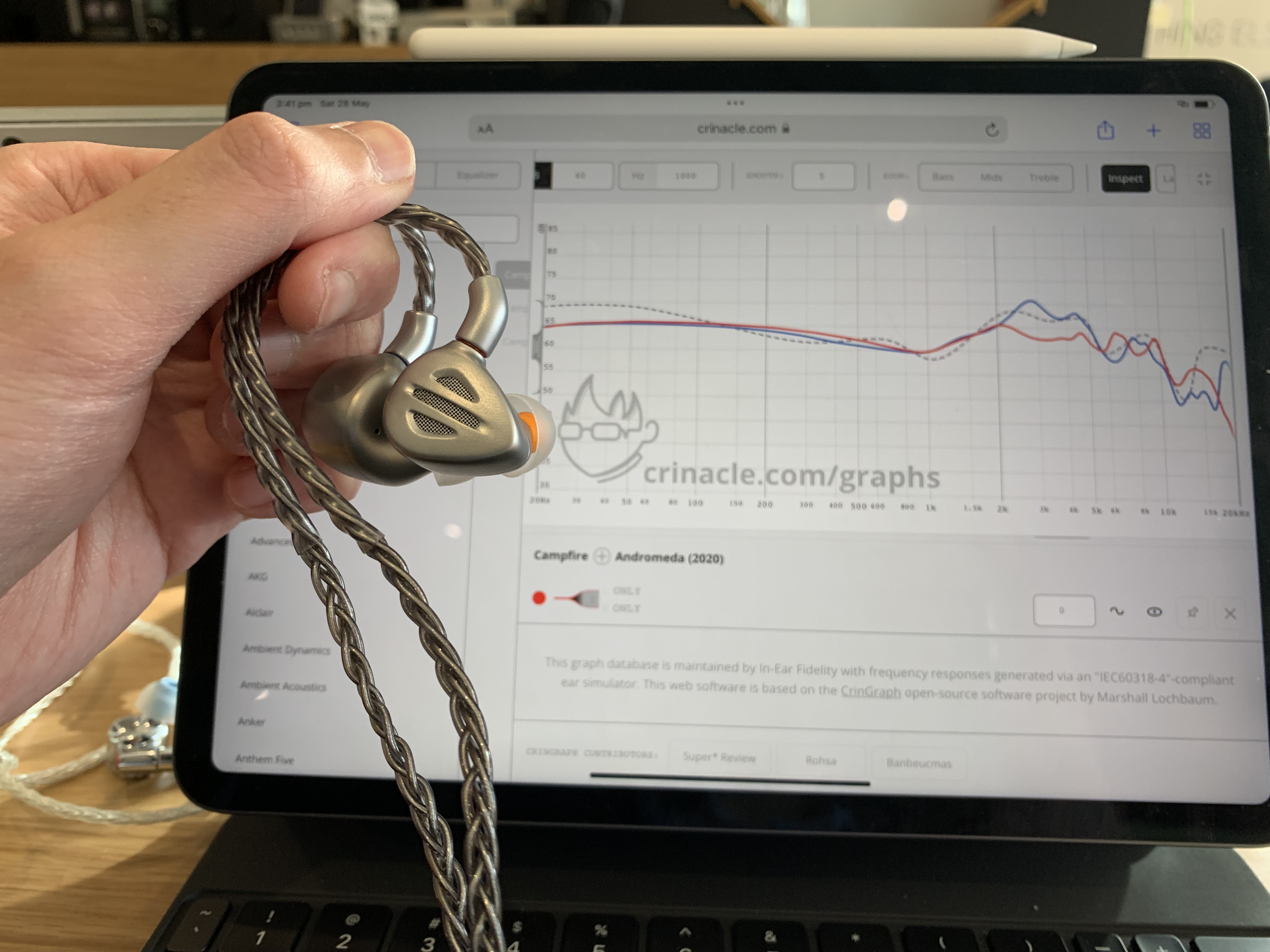tl;dr: Some expensive IEMs are worth it
I’m on the hunt for yet another IEM, as Andromeda is not as satisfying as I hoped. As usual, I visited a local hifi store and auditioned some interesting IEMs. Here are some impressions.
64 Audio Trio - Perfect

Upon hearing Trio the first time, I had a strong sense of familiarity. How come? Because its frequency response perfectly matches my target for EQing most of my IEMs.
How does Trio sound? Powerful, large, engaging, yet controlled and very detailed. Drums and bass instruments are deep and impactful due to 10db subbass boost. Bass lines invoke a strong sense of rhythm and excitement, making you tap and move. Midrange (vocal and instruments) is clear and detailed without being pushed to my face like other “well-tuned” IEMs. There is no midrange shout because the ear-gain is only around 6 to 7db rather than the usual 10db. High-pitched instruments like cymbals and chimes are clear but not harsh. I can hear individual chimes rather than a blob of high-pitched sounds. The resolution across frequency spectrum is very high, and I think Trio’s treble is even better than Andromeda’s.
Soundstage of Trio is spacious and interesting due to several tricks (that you can replicate on your IEMs via EQ). Firstly, Trio pushes the centre image (main vocal and instruments) away from you, reducing the “in-your-head” localisation effect. This trick is performed by dipping 1kHz and 3kHz by around 2db. Secondly, Trio has a steep dip from 10kHz to mimic how high frequencies roll off when listening to loudspeakers, creating the illusion of the sound fading into the surrounding environment. Finally, Trio has that TIA treble with strong peaks from 15kHz up, highlighting the ambience, reverbs, decays, and other background details, creating a strong illusion of layering and distance.
The most interesting aspect of Trio, IMHO, is its dynamic. The music feels lively with a lot of up and down movements. In orchestral music, you can hear contrast between very soft and very loud instruments playing at the same time at different places in the soundstage. This is day and night comparing to my Andromeda 2020, which tends to make everything (nearly) equally loud.
However, it’s not all rosy for Trio. The IEM is still packaged with an old-school cable that is quite uncomfortable and puts a lot of pressure on the connector. The earpieces, surprisingly, are not as well machined as I expected, especially around the vents at the bottom. The worst part is that it is nearly AUD $3500. That money can get you a good IEM, a decent planar headphone, and a DAP from Fiio or A&K.
So, as perfect as Trio is, it’s not something I am too eager to get.
Dunu SA3 - Practical, affordable, and obsolete

When I arrived at the store, another customer was auditioning Dunu SA3. At first, I thought it was a custom IEM due to its look and how it perfectly fills up the customer’s conchas. After going through a selection of IEMs, including the famed Fiio FH5, the customer picked SA3. This event made me curious about SA3, the baby brother of the excellent SA6.
How does SA3 sound? Vocal focused. You can still hear bass and treble but the focus of this IEM is voice and main instruments like guitar. The midrange is pushed to your face and the soundstage is definitely in-your-head, highlighting vocal details. However, the resolution is nothing special. If you have heard Aria or Titan S, you have already heard the technical performance level of SA3. To me, it’s a bit disappointing because I expect a full-BA configuration to outperform single-DD.
The practical aspects of SA3 are the stars of the show, IMHO. As usual, Dunu provides excellent accessories. The earpieces are sturdy and beautiful. The fit and passive isolation of this IEM is exceptional due to having thin and long nozzles. I can see SA3 being used as an on-stage or in-studio monitoring tool.
Would I buy SA3? No. The reason is simple, Dunu SA4 is coming, promising better performance across the board.
Fiio FH9 - It does NOT sound like its graph

I followed the news of FH9 with great enthusiasm. And then I forgot about this IEM after seeing its graph. Thus, I was curious but not very enthusiastic to try FH9. Boy, how wrong I was.
How does FH9 sound? Strong, large, and clear. The graph suggests that FH9 has a warm sound with not much bass punch, similarly to Andromeda 2020. However, for some reason that I do not know, FH9 renders drums and bass instruments with a lot of power. It does not punch deep like Trio or other other subbass-focused IEMs. Instead, the bass feels large, not unlike some JH Audio IEMs. The midrange is natural and clear. The honkiness of FH3 and FH5s is gone. Treble no longer has that hissy, metallic sound of FH5s. FH9 renders cymbals and chimes with great details and separation. The dynamic of FH9 is great.
Soundstage of FH9 feels spacious even though the midrange is pushed to your face. I suspect this has something to do with the semi-open design, as I hear the same kind of effect on my FD5.
Packaging and accessories are similar to FD5. You get plenty of tips, a very nice cable with interchangeable plugs, and a nice leather case. The earpieces are a bit heavy. Even though they are metal, they are surprisingly warm, unlike FD5.
Would I buy FH9? Possibly. I like it more than my Andromeda thanks to the dynamic and bass. But I need to do more audition. It still baffles me how FH9 does not sound like its graph.
Fiio FD7 - Perfected FD5

Fiio FD5 was my dream IEM when I started this “hobby”. It sounds clear, tactile, and open. Accessories are plenty and high quality. So, despite all the negative feedback from famous reviewers (“generic V-shape sound”, “mediocre”, “just get Blessing 2”), I got FD5. There are ups and downs, but I always returned to this IEM.
So, how can FD7 justify its price tag? By perfecting FD5, of course. Similarly to the rest of the FD series, FD7 has a Harman-inspired tuning. However, the ear-gain region has been reduced a couple db comparing to FD5, making FD7’s voicing a bit lusher and less forward yet still “well-tuned”. FD7 reduces the 5kHz peak to a reasonable level to maintain a tactile, snappy feeling of kick drums and guitars without sounding spiky like FD5. Treble region is much more resolved comparing to FD5, allowing me to hear details rather than blobs of high-pitched sound. The treble is not as grainy as Blessing 2 either. Resolution across the frequency spectrum has also been improved. Not top-notch, but I did not feel lacking either. Again, dynamic is great.
Not everything is rosy, though. Similarly to FD5, FD7 does not have very deep bass. Yes, drums are loud and tactile. However, they do not produce that subbass punch that you can feel in your throat like Trio, Blessing 2, or Final E5000. I want a bit more.
Packaging and accessories are similar to FH9. The earpieces look like black FD5. However, I think Fiio might have adjusted the earpieces a bit because FD7 (similarly to the newly released FA7s) fits my ears flusher than FD5.
Would I buy FD7? Possibly. None of the expensive IEMs reaching 1k AUD mark is “sensible”, IMHO, but FD7 and FH9 are more sensible than many. I plan to compare both against Dunu SA6 and Dunu EST112 in the future before any decision.
